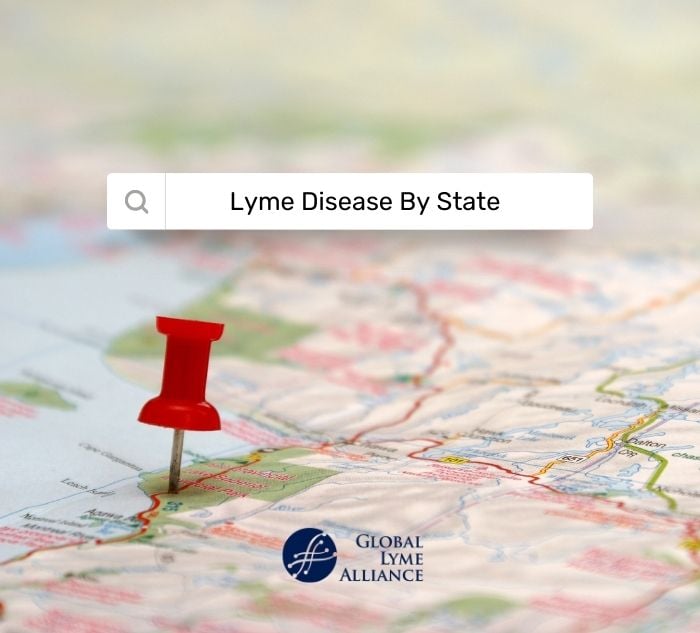
Lyme disease is no longer confined to the woods of New England. Learn how to protect yourself from tick bites and prevent tick-borne illnesses while traveling in the United States.
Lyme disease used to be thought of as a risk only in the woods of New England, but thanks to factors like climate change, this serious bacterial infection caused by the bite of a black-legged tick infected with Borrelia burgdorferi is now a problem in all 50 of the United States. A staggering 476,000 Lyme disease cases are reported in the U.S. each year. Anyone who spends time outdoors—whether hiking, hunting, gardening, or simply playing in the backyard—is at risk for a tick bite that could transmit the bacterium Borrelia burgdorferi and other pathogens, causing Lyme borreliosis and/or other tick-borne diseases.
The Prevalence of Lyme Disease by Region and Activities
While the geographic distribution of black-legged ticks (Ixodes scapularis in the Eastern U.S. and Ixodes pacificus on the West coast) is more prevalent in certain hot spots, you can come across an infected tick and get a tick-borne disease anywhere in the U.S. and in several countries abroad, too. Tick-infested areas tend to be in the Northeastern United States (such as Connecticut, New York, Massachusetts, Vermont, New Hampshire, and Maine) and the Upper Midwest (in states like Ohio and Minnesota). There are also many black-legged ticks up and down the West coast. For a specific map of Lyme disease cases by state, see the Centers for Disease Control and Prevention Lyme Disease Map.
Whether you live in a Lyme disease hotspot or not, you still could be at risk for tick-borne illnesses. It’s very important to remember to think about ticks when you’re traveling. If you live in a state where black-legged ticks are not as prevalent, like Florida, but you take a vacation to Maine, you’ll need to take precautions against tick bites while you’re there. Ticks like to live in moist, shady areas like wood piles, leaf litter, grassy areas, beach dunes, bushy areas, stone walls, wooded areas, and perimeters where the lawn meets the woods. If you’re spending time outdoors hiking, hunting, golfing, or even walking, ticks should be on your radar.
Unfortunately, it’s not just black-legged ticks you need to worry about. While they don’t carry the Lyme disease bacterium, other types of ticks in different regions of the country can transmit pathogens that cause different tick-borne diseases such as Rocky Mountain Spotted Fever or Alpha Gal syndrome (which causes an allergic reaction to red meat).
Signs, Symptoms and Diagnosis
Lyme disease can be difficult to diagnosis because symptoms are similar to many other illnesses. At first, Lyme disease might seem like another flu-like illness. Early symptoms of Lyme disease can include:
- Erythema migrans rash (sometimes shaped like a bullseye; while this rash is a telltale sign of Lyme disease, not everyone gets or notices one)
- Fever
- Fatigue
- Aches
- Chills
- Swollen lymph nodes
- Other flu-like symptoms
Untreated Lyme disease will progress to various parts of the body like the heart and joints, sometimes crossing the blood-brain barrier into the nervous system. Later stages of Lyme disease can mimic conditions like rheumatoid arthritis, lupus, and Myalgic Encephalomyeltis (ME/CFS). Symptoms can include:
- Severe headache and neck stiffness
- Lyme arthritis
- Lyme carditis
- Muscle aches and joint pains
- Facial paralysis on one or both sides
- Numbness or tingling in the hands and feet
- Severe extreme fatigue
- Brain fog and other cognitive impairment
- Sleep impairment
Current laboratory testing for Lyme disease only looks for antibodies against Borrelia burgdorferi but can’t detect the bacteria itself. This means that testing is indirect and often faulty. As a result, Lyme disease is a clinical diagnosis. A healthcare provider will make a diagnosis of a probable case based on a person’s symptoms, their known or suspected exposure to black-legged ticks, and their location (home or travel). Blood tests can corroborate a diagnosis but are not used alone to determine if someone has Lyme disease. Sometimes a healthcare provider might do a spinal tap (testing the cerebrospinal fluid for Lyme bacteria) if neurological Lyme is suspected, but usually the diagnosis is made clinically.
Prevention and Control
The best method of disease control against tick-borne disease is to take preventive measures. Best practices involve being Tick AWARE:
- AVOID tick-infested areas like tall grass, wooded areas, and leaf litter.
- WEAR light-colored protective clothing to spot ticks more easily, such as long-sleeved shirt tucked in at the waist, long pants tucked into high socks, closed-toe shoes, and a hat with your hair tucked in. Do not walk in the grass barefoot or in open sandals, even if it’s a shortcut.
- APPLY EPA-approved insect repellent (with active ingredient DEET or picaridin) to skin and insecticide (such as permethrin) to clothing and shoes as directed.
- REMOVE clothing upon entering the home and toss into the dryer at high temperature for 10-15 minutes to kill live ticks (putting them in the washer won’t work).
- EXAMINE yourself and your pets for ticks daily. Feel for bumps paying close attention the back of knees, groin, armpits, in and behind the ears, belly button, and scalp.
Take special care to follow these prevention measures when you’re doing activities outdoors, either at home or traveling to a new state.
How Global Lyme Alliance Can Help
Global Lyme Alliance offers resources for Lyme disease prevention that are perfect for people involved in various outdoor activities in all 50 states. GLA also has information on Lyme disease treatment and other tick-borne diseases. In addition to taking preventive measures, GLA encourages anyone with symptoms of Lyme disease or a known tick bite to consult with their healthcare provider for proper diagnosis and treatment plans
***








-2.jpg)